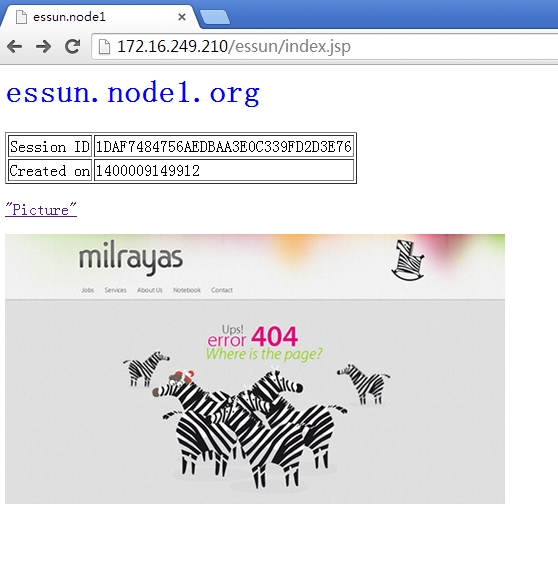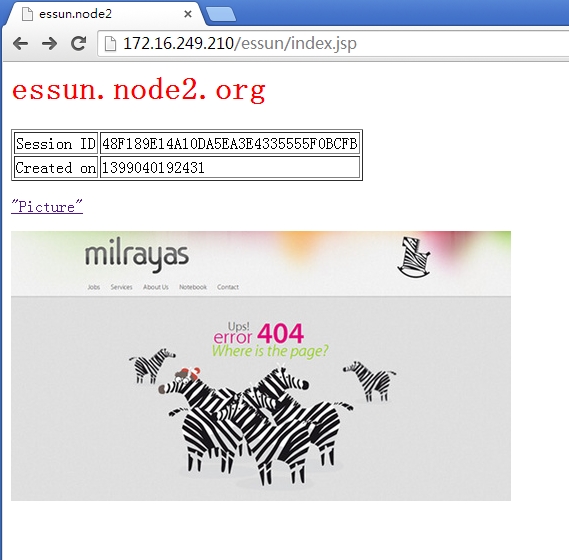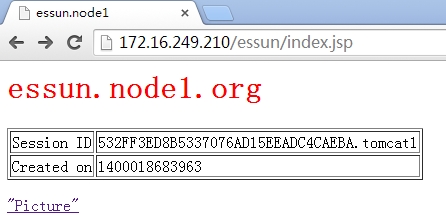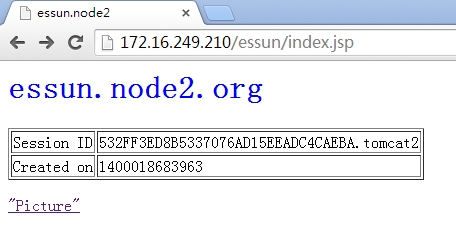Notepad++Good Luck To You!
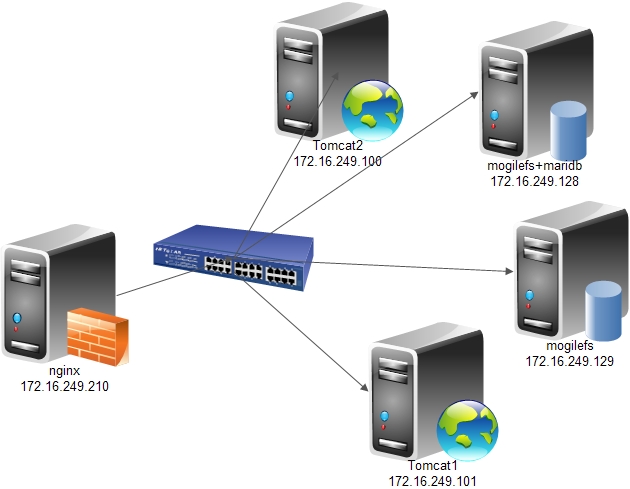
第一部分:nginx反向代理tomcat一、软件及环境软件系统角色用途安装的软件ip地址Centos6.5x86_64nginx反向代理用户请求nginx172.16.249.210Centos6.5x86_64tomcat1处理jsp请求jdk+t...
第一部分:nginx反向代理tomcat
一、软件及环境
软件
| 系统 | 角色 | 用途 | 安装的软件 | ip地址 |
| Centos6.5x86_64 | nginx | 反向代理用户请求 | nginx | 172.16.249.210 |
| Centos6.5x86_64 | tomcat1 | 处理jsp请求 | jdk+tomcat | 172.16.249.101 |
| Centos6.5x86_64 | tomcat2 | 172.16.249.100 | ||
| Centos6.5x86_64 | mog(ilefs/store) | 分布式存储静态数据 | mogilefs | 172.16.249.129 |
| Centos6.5x86_64 | mog(ilefs/store)+mariadb | 172.16.249.128 |
拓扑图
二、实现过程
1、nginx安装
配置文件如下:
1 2 3 4 5 6 7 8 9 10 11 12 13 14 15 16 17 18 19 20 21 22 23 24 25 26 27 28 29 30 31 32 33 34 35 36 37 38 39 40 41 42 43 44 45 46 47 48 49 50 51 52 53 54 55 56 57 58 59 60 61 62 63 64 65 66 67 68 | #user nobody;worker_processes 1;#error_log logs/error.log;#error_log logs/error.log notice;#error_log logs/error.log info;#pid logs/nginx.pid;events { worker_connections 1024;}http { include mime.types; default_type application/octet-stream; #log_format main '$remote_addr - $remote_user [$time_local] "$request" ' # '$status $body_bytes_sent "$http_referer" ' # '"$http_user_agent" "$http_x_forwarded_for"'; #access_log logs/access.log main; sendfile on; #tcp_nopush on; #keepalive_timeout 0; keepalive_timeout 65; #gzip on;upstream mogfs_cluster { server 172.16.249.128:7001; server 172.16.249.129:7001; }upstream jsp_server { server 172.16.249.100:8080; server 172.16.249.101:8080;} server { listen 80; # server_name localhost; # location / { # root html; # index index.html index.htm; # } location ~* ^(/images/.*)$ { mogilefs_tracker mogfs_cluster; mogilefs_domain images; mogilefs_noverify on; mogilefs_pass $1 { proxy_pass $mogilefs_path; proxy_hide_header Content-Type; proxy_buffering off;}} location ~* ^(/text/.*)$ { mogilefs_tracker mogfs_cluster; mogilefs_domain text; mogilefs_noverify on; mogilefs_pass $1 { proxy_pass $mogilefs_path; proxy_hide_header Content-Type; proxy_buffering off;}} location ~* (\.jsp|do)$ { proxy_pass http://jsp_server; } error_page 500 502 503 504 /50x.html; location = /50x.html { root html; } }} |
tomcat1配置文件如下(server.xml)
1 2 3 4 5 6 7 8 9 10 11 12 13 14 15 16 17 18 19 20 21 22 23 24 25 26 27 28 29 30 31 32 33 34 35 36 37 38 39 40 41 42 43 44 45 46 47 48 49 50 51 52 53 54 55 56 57 58 59 60 61 62 63 64 65 66 67 68 69 70 71 72 73 74 75 76 77 78 79 80 81 82 83 84 85 86 87 88 89 90 91 92 93 94 95 96 97 98 99 100 101 102 103 104 105 106 107 108 109 110 111 112 113 114 115 116 117 118 119 120 121 122 123 124 125 126 127 128 129 130 131 132 | <?xml version='1.0' encoding='utf-8'?><!-- Licensed to the Apache Software Foundation (ASF) under one or more contributor license agreements. See the NOTICE file distributed with this work for additional information regarding copyright ownership. The ASF licenses this file to You under the Apache License, Version 2.0 (the "License"); you may not use this file except in compliance with the License. You may obtain a copy of the License at http://www.apache.org/licenses/LICENSE-2.0 Unless required by applicable law or agreed to in writing, software distributed under the License is distributed on an "AS IS" BASIS, WITHOUT WARRANTIES OR CONDITIONS OF ANY KIND, either express or implied. See the License for the specific language governing permissions and limitations under the License.--><!-- Note: A "Server" is not itself a "Container", so you may not define subcomponents such as "Valves" at this level. Documentation at /docs/config/server.html --><Server port="8005" shutdown="SHUTDOWN"> <!-- Security listener. Documentation at /docs/config/listeners.html <Listener className="org.apache.catalina.security.SecurityListener" /> --> <!--APR library loader. Documentation at /docs/apr.html --> <Listener className="org.apache.catalina.core.AprLifecycleListener" SSLEngine="on" /> <!--Initialize Jasper prior to webapps are loaded. Documentation at /docs/jasper-howto.html --> <Listener className="org.apache.catalina.core.JasperListener" /> <!-- Prevent memory leaks due to use of particular java/javax APIs--> <Listener className="org.apache.catalina.core.JreMemoryLeakPreventionListener" /> <Listener className="org.apache.catalina.mbeans.GlobalResourcesLifecycleListener" /> <Listener className="org.apache.catalina.core.ThreadLocalLeakPreventionListener" /> <!-- Global JNDI resources Documentation at /docs/jndi-resources-howto.html --> <GlobalNamingResources> <!-- Editable user database that can also be used by UserDatabaseRealm to authenticate users --> <Resource name="UserDatabase" auth="Container" type="org.apache.catalina.UserDatabase" description="User database that can be updated and saved" factory="org.apache.catalina.users.MemoryUserDatabaseFactory" pathname="conf/tomcat-users.xml" /> </GlobalNamingResources> <!-- A "Service" is a collection of one or more "Connectors" that share a single "Container" Note: A "Service" is not itself a "Container", so you may not define subcomponents such as "Valves" at this level. Documentation at /docs/config/service.html --> <Service name="Catalina"> <!--The connectors can use a shared executor, you can define one or more named thread pools--> <!-- <Executor name="tomcatThreadPool" namePrefix="catalina-exec-" maxThreads="150" minSpareThreads="4"/> --> <!-- A "Connector" represents an endpoint by which requests are received and responses are returned. Documentation at : Java HTTP Connector: /docs/config/http.html (blocking & non-blocking) Java AJP Connector: /docs/config/ajp.html APR (HTTP/AJP) Connector: /docs/apr.html Define a non-SSL HTTP/1.1 Connector on port 8080 --> <Connector port="8080" protocol="HTTP/1.1" connectionTimeout="20000" redirectPort="8443" /> <!-- A "Connector" using the shared thread pool--> <!-- <Connector executor="tomcatThreadPool" port="8080" protocol="HTTP/1.1" connectionTimeout="20000" redirectPort="8443" /> --> <!-- Define a SSL HTTP/1.1 Connector on port 8443 This connector uses the JSSE configuration, when using APR, the connector should be using the OpenSSL style configuration described in the APR documentation --> <!-- <Connector port="8443" protocol="HTTP/1.1" SSLEnabled="true" maxThreads="150" scheme="https" secure="true" clientAuth="false" sslProtocol="TLS" /> --> <!-- Define an AJP 1.3 Connector on port 8009 --> <Connector port="8009" protocol="AJP/1.3" redirectPort="8443" /> <!-- An Engine represents the entry point (within Catalina) that processes every request. The Engine implementation for Tomcat stand alone analyzes the HTTP headers included with the request, and passes them on to the appropriate Host (virtual host). Documentation at /docs/config/engine.html --> <!-- You should set jvmRoute to support load-balancing via AJP ie : <Engine name="Catalina" defaultHost="localhost" jvmRoute="jvm1"> --> <Engine name="Catalina" defaultHost="localhost"> <!--For clustering, please take a look at documentation at: /docs/cluster-howto.html (simple how to) /docs/config/cluster.html (reference documentation) --> <!-- <Cluster className="org.apache.catalina.ha.tcp.SimpleTcpCluster"/> --> <!-- Use the LockOutRealm to prevent attempts to guess user passwords via a brute-force attack --> <Realm className="org.apache.catalina.realm.LockOutRealm"> <!-- This Realm uses the UserDatabase configured in the global JNDI resources under the key "UserDatabase". Any edits that are performed against this UserDatabase are immediately available for use by the Realm. --> <Realm className="org.apache.catalina.realm.UserDatabaseRealm" resourceName="UserDatabase"/> </Realm> <Host name="www.essun.org" appBase="webapps" unpackWARs="true" autoDeploy="true"> <Context path="" docBase="essun" /> <Valve className="org.apache.catalina.valves.AccessLogValve" directory="logs" prefix="essun_access_log." suffix=".txt" pattern="%h %l %u %t "%r" %s %b" /> </Host> <Host name="localhost" appBase="webapps" unpackWARs="true" autoDeploy="true"> <!-- SingleSignOn valve, share authentication between web applications Documentation at: /docs/config/valve.html --> <!-- <Valve className="org.apache.catalina.authenticator.SingleSignOn" /> --> <!-- Access log processes all example. Documentation at: /docs/config/valve.html Note: The pattern used is equivalent to using pattern="common" --> <Valve className="org.apache.catalina.valves.AccessLogValve" directory="logs" prefix="localhost_access_log." suffix=".txt" pattern="%h %l %u %t "%r" %s %b" /> </Host> </Engine> </Service></Server> |
站点目录文件如下
1 2 3 4 5 6 7 8 9 10 11 12 13 14 15 16 17 18 19 20 21 22 23 24 25 26 27 28 | [root@essun tomcat]# cd webapps/essun/[root@essun essun]# lsindex.jsp WEB-INF[root@essun essun]# ll WEB-INF/total 8drwxr-xr-x 2 root root 4096 May 2 11:07 classesdrwxr-xr-x 2 root root 4096 May 2 11:07 lib[root@essun essun]# cat index.jsp<%@ page language="java" %><html> <head><title>essun.node2</title></head> <body> <h1><font color="red">essun.node2.org</font></h1> <table align="centre" border="1"> <tr> <td>Session ID</td> <% session.setAttribute("essun.org","essun.org"); %> <td><%= session.getId() %></td> </tr> <tr> <td>Created on</td> <td><%= session.getCreationTime() %></td> </tr> </table><p><a href="http://172.16.249.210/images/4.jpg">"Picture"</a></p><% out.println("<img src='http://172.16.249.210/images/3.jpg'>"); %></body></html> |
tomcat2 与此处的配置相同,仅 index.jsp有所不同
1 2 3 4 5 6 7 8 9 10 11 12 13 14 15 16 17 18 19 20 21 | [root@essun essun]# cat index.jsp<%@ page language="java" %><html> <head><title>essun.node1</title></head> <body> <h1><font color="blue">essun.node1.org</font></h1> <table align="centre" border="1"> <tr> <td>Session ID</td> <% session.setAttribute("essun.org","essun.org"); %> <td><%= session.getId() %></td> </tr> <tr> <td>Created on</td> <td><%= session.getCreationTime() %></td> </tr> </table> <p><a href="http://172.16.249.210/images/4.jpg">"picture"</a></p><% out.println("<img src='http://172.16.249.210/images/3.jpg'>"); %></body></html> |
配置文件中只要修改对应的ip地址即可
4、测试
访问nginx
刷新后的结果
己经通过nginx中的proxy_pass为tomcat反向代理
注:
<a href="http://172.16.249.210/images/4.jpg">"picture"</a></p><% out.println("<img src='http://172.16.249.210/images/3.jpg'>"); %>这两处的url都是nginx反向代理mogilefs的url.
第二部分、实现session会话同步(DeltaManager方式)
tomcat会话管理
会话分类
标准会话管理器和持久会话管理器
标准会话管理器(StandardManager)
1 2 | <Manager className="org.apache.catalina.session.StandardManager" maxInactiveInterval="7200"/> |
默认保存于$CATALINA_HOME/work/Catalina/<hostname>/<webapp-name>/下的SESSIONS.ser文件中。
maxActiveSessions:最多允许的活动会话数量,默认为-1,表示不限制;
maxInactiveInterval:非活动的会话超时时长,默认为60s;
pathname:会话文件的保存目录; 持久会话管理器(PersistentManager):将会话数据保存至持久存储中,并且能在服务器意外中止后重新启动时重新加载这些会话信息。持久会话管理器支持将会话保存至文件存储(FileStore)或JDBC存储(JDBCStore)中。
保存至文件中的示例
1 2 3 4 5 | <Manager className="org.apache.catalina.session.PersistentManager" saveOnRestart="true"> <Store className="org.apache.catalina.session.FileStore" directory="/data/tomcat-sessions"/> </Manager> |
每个用户的会话会被保存至directory指定的目录中的文件中,文件名为.session,并通过后台线程每隔一段时间(checkInterval参数定义,默认为60秒)检查一次超时会话。
保存至JDBCStore中的示例
1 2 3 4 5 6 | <Manager className="org.apache.catalina.session.PersistentManager" saveOnRestart="true"> <Store className="org.apache.catalina.session.JDBCStore" driverName="com.mysql.jdbc.Driver" connectionURL="jdbc:mysql://localhost:3306/mydb?user=jb;password=pw"/> </Manager> |
Manger对象用于实现HTTP会话管理的功能,Tomcat6中有4种Manger的实现:
StandardManagerTomcat7的默认会话管理器,用于非集群环境中对单个处于运行状态的Tomcat实例会话进行管理。当Tomcat关闭时,这些会话相关的数据会被写入磁盘上的一个名叫SESSION.ser的文件,并在Tomcat下次启动时读取此文件。
PersistentManager当一个会话长时间处于空闲状态时会被写入到swap会话对象,这对于内存资源比较吃紧的应用环境来说比较有用。
DeltaManager用于Tomcat集群的会话管理器,它通过将改变了的会话数据同步给集群中的其它节点实现会话复制。这种实现会将所有会话的改变同步给集群中的每一个节点,也是在集群环境中用得最多的一种实现方式。
BackupManager用于Tomcat集群的会话管理器,与DeltaManager不同的是,某节点会话的改变只会同步给集群中的另一个而非所有节点。
注 :
负载均衡,且实现会话绑定要注意给每个tomcat实例的egine容器一个jvmRoute属性!此名称要跟前端调度模块使用名称保持一致!另外,在mod_proxy实现负载均衡的会话绑定时,还要使用sticksession=JSESSIONID(字符要大写)!
1、分别打开tomcat1和tomcat2下conf中server.xml
1 2 3 4 5 6 7 8 | <Server port="8005" shutdown="SHUTDOWN"><!-- Define a non-SSL HTTP/1.1 Connector on port 8080 --> <Connector port="8080" maxHttpHeaderSize="8192"maxThreads="150" minSpareThreads="25" maxSpareThreads="75"enableLookups="false" redirectPort="8443" acceptCount="100"connectionTimeout="20000" disableUploadTimeout="true" /><!-- Define an AJP 1.3 Connector on port 8009 --><Connector port="8009" enableLookups="false" redirectPort="8443"protocol="AJP/1.3" /> |
找到<Engine name="Catalina" defaultHost="localhost">
Tomcat1下的修改为
1 | <Engine name="Catalina" defaultHost="localhost" jvmRoute="tomcat1"> |
Tomcat2下的修改为<Engine name="Catalina" defaultHost="localhost" jvmRoute="tomcat2">
2、修改tomcat1中的Cluster className tomcat1找到 修改为
1 2 3 4 5 6 7 8 9 10 11 12 13 14 15 16 17 18 19 20 21 22 23 24 25 26 27 28 29 30 31 32 33 34 35 36 37 38 39 | <!--<Cluster className="org.apache.catalina.ha.tcp.SimpleTcpCluster"/> -->#在这以下为添加内容 <Cluster className="org.apache.catalina.ha.tcp.SimpleTcpCluster" channelSendOptions="8"> <Manager className="org.apache.catalina.ha.session.DeltaManager" expireSessionsOnShutdown="false" notifyListenersOnReplication="true"/> <Channel className="org.apache.catalina.tribes.group.GroupChannel"> <Membership className="org.apache.catalina.tribes.membership.McastService" address="228.0.0.4" port="45564" frequency="500" dropTime="3000"/> <Receiver className="org.apache.catalina.tribes.transport.nio.NioReceiver" address="172.16.249.101" port="4000" autoBind="100" selectorTimeout="5000" maxThreads="6"/> <Sender className="org.apache.catalina.tribes.transport.ReplicationTransmitter"> <Transport className="org.apache.catalina.tribes.transport.nio.PooledParallelSender"/> </Sender> <Interceptor className="org.apache.catalina.tribes.group.interceptors.TcpFailureDetector"/> <Interceptor className="org.apache.catalina.tribes.group.interceptors.MessageDispatch15Interceptor"/> </Channel> <Valve className="org.apache.catalina.ha.tcp.ReplicationValve" filter=""/> <Valve className="org.apache.catalina.ha.session.JvmRouteBinderValve"/> <Deployer className="org.apache.catalina.ha.deploy.FarmWarDeployer" tempDir="/tmp/war-temp/" deployDir="/tmp/war-deploy/" watchDir="/tmp/war-listen/" watchEnabled="false"/> <ClusterListener className="org.apache.catalina.ha.session.JvmRouteSessionIDBinderListener"/> <ClusterListener className="org.apache.catalina.ha.session.ClusterSessionListener"/> </Cluster> |
3、将conf/web.xml复制一份到发布的站点目录WEB-INF下,在</web-app>前面加入以下这句话<distributable/>
如我的站点目录为
1 2 3 4 5 6 | [root@essun tomcat]# cd webapps/essun/[root@essun essun]# ll WEB-INF/total 168drwxr-xr-x 2 root root 4096 May 14 04:40 classesdrwxr-xr-x 2 root root 4096 May 14 04:40 lib-rw------- 1 root root 162921 May 14 04:40 web.xml |
4、在各节点为使用组播地址添加组播路由,格式:
1 | route add -net $MCAST_ADDRESS netmask 255.255.255.255 dev eth0 |
如我自己的地址为
1 | route add -net 228.0.0.4 netmask 255.255.255.255 dev eth0 |
而在tomcat2上只有两处与tomcat1不同,其它操作都一样
jvmRoute="tomcat2"
address="172.16.249.101"
address最好是当前节点的主机地址
session同步到这里设置完毕。
看一下效果
还有一张
服务器的启动顺序如下:
tomcat1 --> |tomcat2 --> |nginx
先启动tocmat1,等tomcat1启动完全的时候再启动tomcat2,等两个tocmat全启动之后,再启动nginx负载的时候可以用APACHE或NGINX,如果什么都不用,两台一接防问了话,可能会出错极session不同步的问题,网上也很多人介意不要做seeeion同步,这样会降低机器的性能,有一个方法可以,就是NGINX的ip_hash,这样至少可以保证客户端去防问同一台TOCMAT,除非那台TOCMAT挂了
全文详见:http://xpxw.com/?id=29
